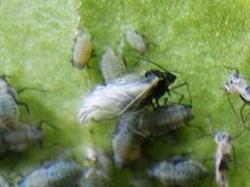Mung bean pest: wild bean borer

(1) Harm condition also known as cowpea pod borer, pod wild borer, cowpea borer. It is widely distributed in China and occurs seriously south of the Yangtze River. Larvae eat host flower organs, resulting in flower drop; eat pod, early cause pod drop, late cause pod and seed rot. In addition, it can also spin silk to wrap several leaves together, larvae eat mesophyll in it; or eat tender stems, causing withered shoots, which has a great impact on yield and quality. (2) Morphological characteristics: adult 13 mm long, wings 24~26 mm, dark yellow brown, two white transparent spots in the center of front wing, white translucent after wing, dark brown ripples inside. The eggs are flat oval, pale green, with hexagonal reticulation. The mature larvae are 18 mm long, brown in head and chest, and yellowish green in body. The pupa is 13 mm long and yellowish brown. (3) The number of generations of living habits varies from place to place in a year. The adults are active from 21:00 to 1:00 midnight. They have phototaxis. Bean borer is a warm-loving pest, especially in southern China. For example, in North China, it can have 3~4 generations a year and overwinter as pupae; in South China, it can overwinter as larvae or no obvious overwinter phenomenon. Generally, the peak period of this pest is from June to July to September to October every year. (4) Control methods ① Remove the fallen flowers and pods in time, and remove the injured leaves and pods to reduce the source of insects. (2) Set up black lights in the field to trap adults. (3) Spraying pesticides, such as 800 times solution of 50% dichlorvos emulsifiable concentrate, 3000 times solution of 25% Jule mixture, or 3000~4000 times solution of 10% pesticide, 2.5% deltamethrin, 10% cypermethrin, etc. From budding, spray buds and flowers once every 10 days.
- Prev

Matters needing attention in planting broad bean
Matters needing attention in planting broad bean
- Next

Mung bean pest: control method of vegetable aphid
① insect-resistant varieties in the same kind of vegetables, different varieties have different insect resistance. Such as some hairy varieties, aphids do not like to eat, various places can be selected according to the situation. ② cleans the field many times in time to remove weeds, especially in early spring and late autumn, which can eliminate many insect sources. There are more insects to be pulled out in time during the growing period.
Related
- The first cup of black tea in spring, the flavor and history of tea gardens in Kenya, Africa
- The computer can not only choose potatoes, but also grow tea rice. AI will grow winter oolong tea champion.
- It is not only the inflated tea bitten by insects, but also engraved with the four seasons tea in Beipu.
- The Oriental Beauty Tea Festival in Zhuxian County takes the stage at the weekend to experience the plus-size feast of oil tea.
- & quot; Oriental Beauty Tea & Exploration of Emei in Hsinchu, the hometown of quot;
- The new variety of strawberry "Tainong 1" dessert is the first choice with mellow aroma. Crimson gorgeous
- History of Tea in Taiwan: from Wild Inner Mountain to Export Tea Garden
- Two types of Taiwan Oriental Beauty Black Tea won the British three-Star Award for Childhood Tea Xiang Zhang Jiaqi changed from pilot to champion tea maker.
- Banana species and varieties: the planting history of Taiwan Xianren banana and dwarf banana is long, is banana disease resistant?
- Coffee planting Technology: Qianjie Coffee from Seedling to harvesting

